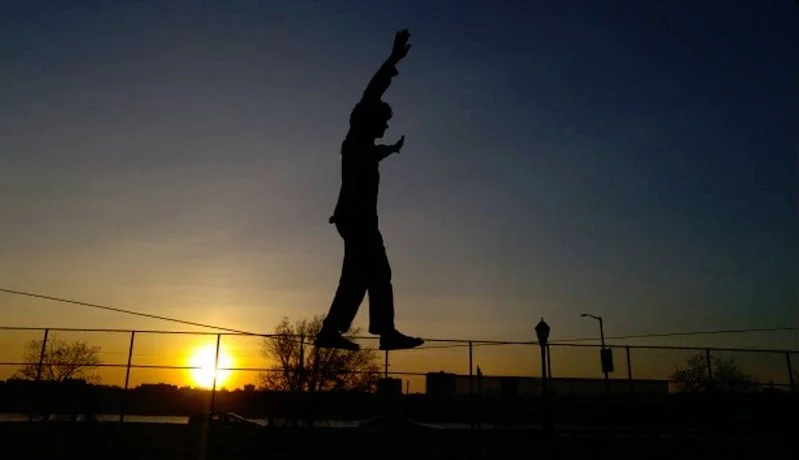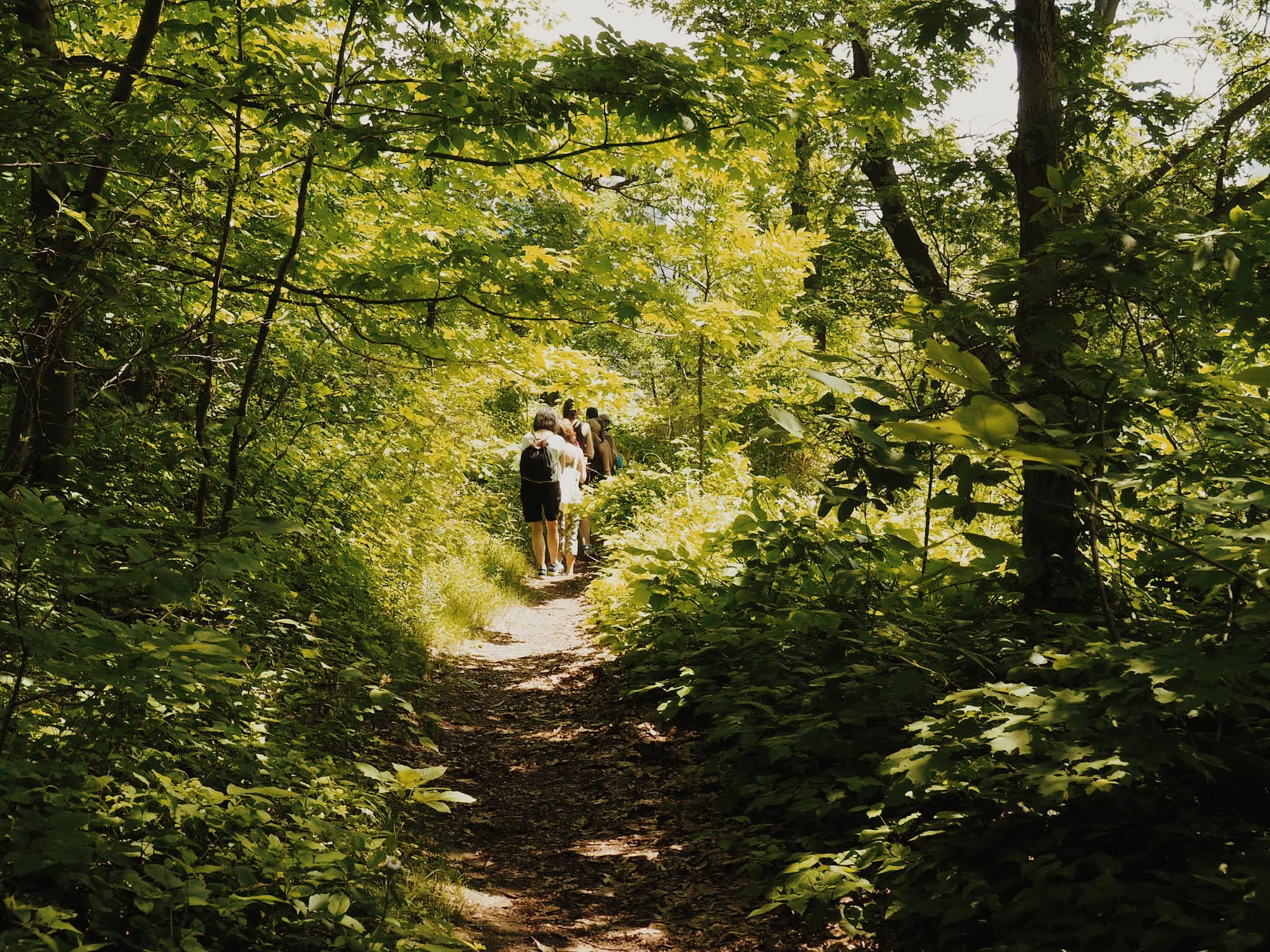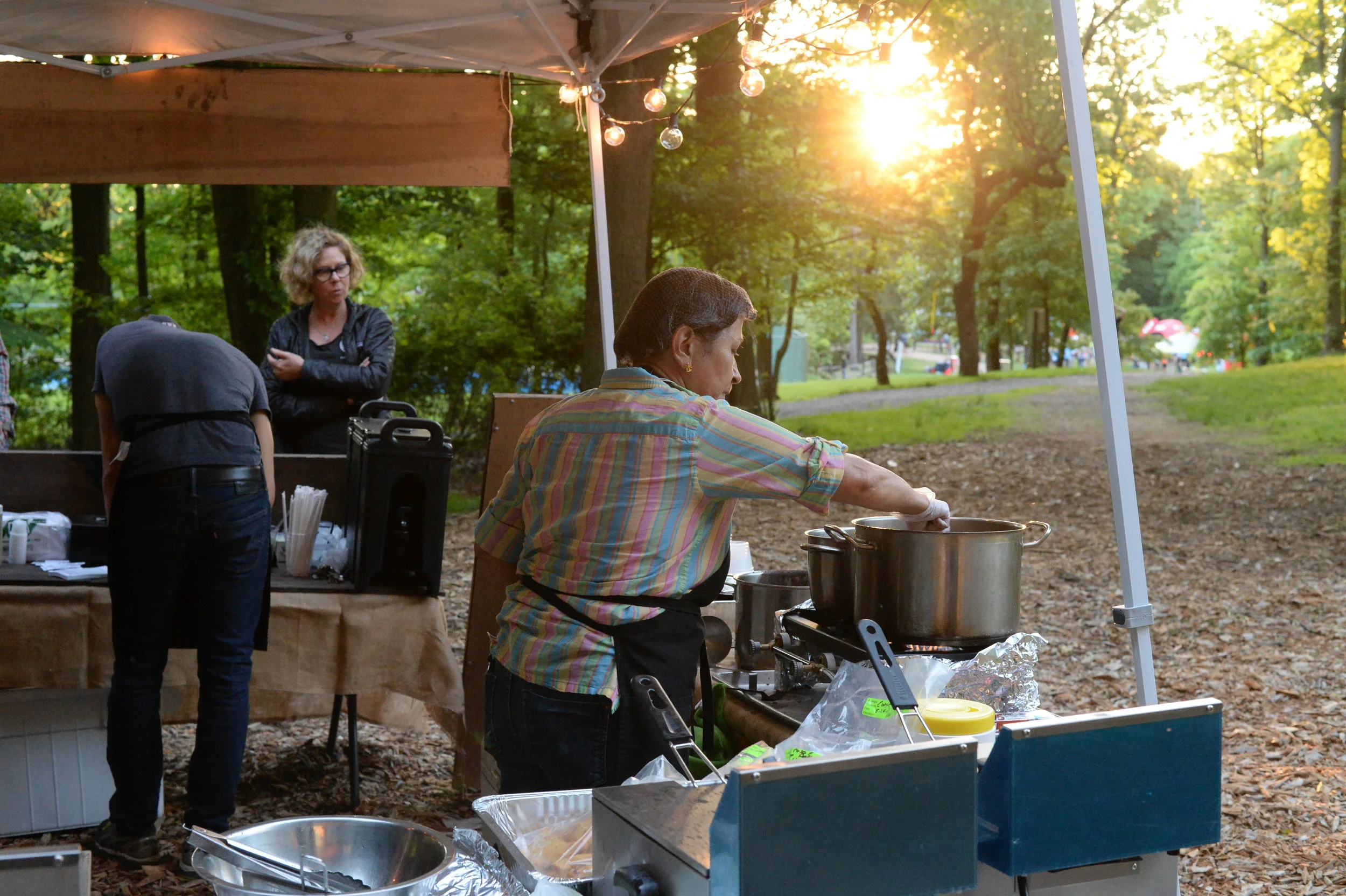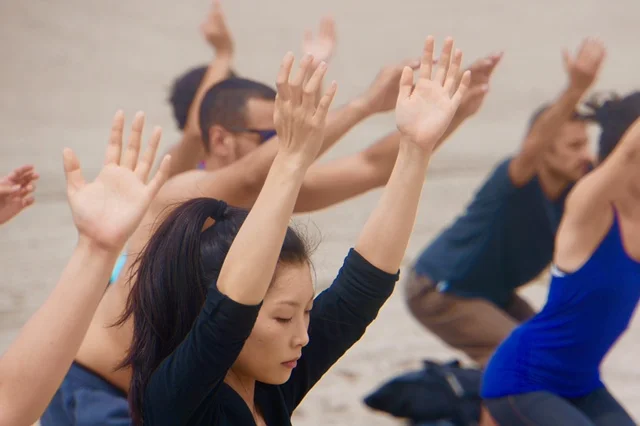The super basic explanation of slacklining for total newbies.
NYC Trails Guide: The Best Hiking in Each Borough
Talking trail with Amanda Stecco
Trying to keep up with Amanda Stecco tends to require copious amounts of coffee.
The spirited 25 year old from Baltimore spends her working hours coordinating social for media giant HBO and all other hours adventuring out in the wild, from Breakneck Ridge to the hallowed trails of Yosemite. She recently ran her first ultramarathon in Wisconsin. We caught up with her about trail running, learning in the backcountry and what she wishes everyone knew about getting outside to play.
How did you get into trail racing?
My first trail experience was at the marathon relay at the North Face Endurance Challenge DC, in 2015. I remember passing back and forth with my friends who were doing the 50k and thinking: whoa, these girls are so badass. The course was really tough. It had rained for days leading up to the race and, at the finish, all muddy and gross, I realized, hey, this is pretty cool! Not long after, my friend Casey told me she signed up for a 50k in Wisconsin and she sent me the link. I went to to a panel discussion on ultrarunning with some local experts and Salomon. I talked all about gear and hydration with them and started to think, I can do this- I signed up that night.
Tell us about race day in Wisconsin.
We drove out to Wisconsin and camped together as a big group; we had good mix of people who were new and experienced runners. Everyone was really chill, which helped calm my nerves. Whitney led a pre-race meditation that was very helpful and I went into the event feeling comfortable. It was warm and the course didn’t have much shade, so I focused on drinking early and often to stay on top of my fluids. To this day, that’s the best running advice I have ever received. The course had so many open fields: every time I got to one, it felt like deja vu; weren’t we just here? At mile 23 I called my friend Liysa who was out on a long run of her own and she was perfect: she asked me all the right questions, like was I still sweating, was I cold, was I eating? When I answered yes to all of them, she said “well then, you’re fine. Go get that finish” and that was the motivation I needed to get it done.
If you could take anyone out on a trail run, who would you pick?
That’s no contest! I would go with my man Barry O: President Obama. He has been such an inspiration to me and I would love to get him talking; just open up. Trail running is the best way to get to know someone; you are out in nature and conversation just flows.
What advice do you have for new trail runners?
Ask all the questions! I learned so much by just reaching out and asking friends what their experiences were like. I’d tell them to think hard about their nutrition and recovery too- that’s a very important aspect of racing that I feel like I am still working on dialing in.
The Five Best Places to Go Fly Fishing Near NYC
5 Ways to get in Shape for Spring Paddling
Empanaderia NYC Returns to the OutdoorFest Campout
Fire with Friction Tip: Bowdrill Posture
1st Annual Escape From New York Day at 718 Cyclery
I used to hate the outdoors until I moved to NYC
Outdoor Essentials: the 2018 Gear Guide
Skiing & Riding from NYC [no car needed]
Camping at Giant Ledge
An Introduction to the Shawangunks
Written by Elliot Becker
The Shawangunks (or more frequently, the Gunks), is the premier climbing crag in the Northeastern U.S. A number of factors conspire to make it so. First there is the location. Two hours from New York City and three to five from Boston, Philadelphia and DC means that for the entire BosWash Megalopolis, the Gunks is an accessible weekend trip for millions of people. The second factor is the quantity of climbing. The Gunks are composed of a number of continuous ridges that, in the case of the main ridge, the Trapps, extends for miles.
Hundreds of climbs are packed throughout this ridge, meaning that visitors have a wide range of routes available to climb in a small area. Adding to that you have the third factor: accessibility. Parking is relatively close to the Trapps, and a short steep walk takes you to well-maintained carriage road extending the length of the Trapps, with paths at intervals up the talus to the base of the wall. The final and most important factor of the Gunks’ virtues is the quality of the climbing. While many crags really shine at certain difficulty grades, the Gunks are composed of a wide range of routes that climbers at any skill level will find compelling. The Gunks are made of a quartz conglomerate, the most notable features of which are the ubiquitous horizontal cracks, ledges and roofs. As a consequence, even a beginning climber will often find themselves moving over airy and exposed routes more often associated with harder grades at other crags.
History plays a role in the importance of Gunks to climbing. The Gunks were first climbed by Fritz Wiessner in 1935. A short, bald German émigré, Wiessner cut a swathe of early first ascents across the U.S. and later the world. He was later joined by another Germanic emigree (from the former Austro-Hungary) Hans Kraus. The two of them put up many of the Gunks’ most classic routes between the 30s and 50s. During that period, grading was nonexistant or much less formal, and climbers climbed with boots or sneakers, protecting themselves with pitons hammered in place and ropes knotted around their waist. The most famous climb at the Gunks, High Exposure, was put up by Kraus in 1941. Because the routes were put up at a time when the grading scale did not go as high, and at a very different time climbing culture (the idea of climbing gym was decades in the future) they retain grades that often feel stiff compared with gyms or more recently developed crags.
The Gunks is almost entirely traditional (trad) climbing. While there is the occasional bolt as needed for protection, the Gunks have retained a very traditional ethic regarding bolting. Further, many of the climbs are two or three pitches. Notably, the Trapps are split for most of the length by the Grand Traverse (GT) Ledge, which allows climbers to maneuver between the lower and upper parts of the wall, and often to mix and match what parts of a given climb they want to do. Taken together, the Gunks is a great place to learn to lead and follow trad in a multi-pitch environment. However, anyone whose only experience is climbing in a gym or sport climbing is advised to get some professional advice before hitting the Gunks.
A good place to start or end a day of climbing at the Gunks is at the venerable local gear shop, Rock and Snow. Started by local climbers, it remains staffed by knowledgeable Gunks veterans. They can recommend whatever you need from gear to guides. In terms of guides, there is one company that has a bit of an advantage, Alpine Endeavors. Most of the Gunks are on a private preserve (one downside to climbing at the Gunks is that a daypass is $17, or $95 for an annual), but one of the most famous areas, Skytop, is part of the Mohonk Mountain House resort. Skytop is home to some of the most famous and historically ground breaking routes, like Foops, Supercrack, and Vandals. The only way you can climb there, though, is if you hire a guide from Alpine Endeavors, which has a deal with Mohonk Mountain House. So if you’re thinking of hiring a guide, you might consider shelling out a bit more so you can climb at Skytop; even if you’re buddies take you climbing in the future, they’re not taking you to Skytop.
5 Ways to Take Hiking to New Heights
Access Fund Summit is Coming to NYC This September
The Access Fund's annual summit is coming to NYC this September. To get a better understanding of the event and why it's important we chatted with the team at the Access Fund based in Boulder.
Let’s start with an easy question, what is Access Fund?
Access Fund was created to be the voice of all climbers and protect the wild places that we love, whether they’re in our backyard or deep in the backcountry. Our mission is about keeping climbing areas open, and conserving the climbing environment. You might see us in Washington D.C., working to ensure that climbing interests are protected at the federal level or if a local climbing spot goes up on the auction block, we may step in to buy the area outright. Our work can also involve connecting with land managers, building trails, or educating climbers to minimize their impacts.
As this sport continues to grow, we have much to celebrate. At the same time we are seeing more impacts and threats to access than ever before. Our mission is to work through these threats and protect the integrity of America’s outdoor climbing areas so all climbers can enjoy them for years to come.
Do you do any work in New York City or upstate New York?
Climbing in Central Park at OutdoorFest 2015 by Tun Khine
We’ve worked in New York for more than two decades, including places like the Gunks, Central Park, and Thacher State Park near Albany. Right now, our team is addressing the current climbing restrictions at the Gunks in Minnewaska State Park. Access Fund, in partnership with the Gunks Climbers’ Coalition, is in the process of opening up a small cliff in an area of the park called Beacon Hill, which will provide climbers with another option when visiting the Gunks. We hope that this effort will be a catalyst for opening up some of the larger cliff lines in the park.
Adirondack Park is another area of interest. There is currently a fixed anchor ban in that park which affects the bolts climbers depend on. Our long-term goal is to work with the park, the Department of Environmental Conservation and other stakeholders to come up with a reasonable fixed anchor policy.
We heard you’re bringing your annual summit to New York City on September 22. Why did you choose to bring this event to our hometown?
It was definitely time to show our East Coast members some love and bring this incredible event to them. We’ve got a long history of working in the state, great local partners, and some recent successes to celebrate like Thacher State Park. We are very fortunate to have strong relationships with our local climbing organizations and climbing gyms in the area, so that made it an obvious choice. The Gunks also offers world-class climbing, and there are numerous other spots just a short drive (editor's Note: or bus ride) away.
What does a typical day at the summit look like?
It’s a diverse and inspiring gathering of climbers from all backgrounds and abilities, from all across the country, that have one thing in common: They really care about the climbing community and the future of our climbing areas. Attendees should expect to be inspired by their peers and a wide variety of speakers, from industry professionals to dedicated local climbing advocates to everyday climbers.
“Attendees should expect to be inspired by their peers and a wide variety of speakers, from industry professionals to dedicated local climbing advocates to everyday climbers.”
We will kick off the day with a Community Roundtable, which is a bit like a town hall, to give each person a voice and bring our climbing family together. After that, we will have four sessions with two concurrent workshops, and attendees can pick the workshop they are interested in, whether it’s listening and joining in a panel discussion or taking in a presentation from an expert. You can view a full schedule here. Lunch is included as well as a yoga session to get participants moving.
What skills can attendees expect to gain from this summit?
We’ve got a lot packed into this year’s agenda. A few skills we will unpack are:
- learning to climb with minimal impact
- starting and maintaining a grassroots organization
- creating public recreational access on private land
- fundraising and marketing for your organization
- helping to expand diversity in your local community.
We also have a panel featuring a biological study from the Gunks, which offers valuable lessons about wildlife and cliff management.
What are three adjectives you'd use to describe the summit?
Relevant, practical, inclusive
What if I'm not a climber (or I only climb indoors?) Should I still attend?
Definitely! We have all kinds of attendees coming for all kinds of reasons. It’s a great way to network and meet other adventurous people in your area. We also intersect with many other outdoor recreational activities and interests – we work with mountain biking organizations, hiking organizations, wildlife biologists, and so many others to accomplish a shared goal of conservation and keeping access open to the beautiful landscapes we crave to spend time in.
We heard there's an after party...?
Our largest party of the year kicks off at 5:30 p.m. that same day! This year, our Annual Dinner will be hosted at the beautiful Edison Ballroom in the heart of New York City. Expect to rub elbows with professional athletes and some of the most influential climbing advocates and legends in the Northeast!
What should we expect at this dinner?
Our Annual Dinner continues to be the highlight event of the year. Join us for a 1920s inspired cocktail hour and dinner featuring Timmy O’Neill as our engaging emcee, and world-renowned climber Lynn Hill as our keynote speaker. There will also be a silent and live auction for some incredible gear packages, getaways, and more. The unforgettable evening will be a chance to connect with friends, celebrate our access and conservation successes, and fuel the ongoing effort to protect America’s public lands and climbing areas.
If I can't make it, where do I go to stay in touch / get more info / help out?
Check out our webpage for the event here and reach out to summit@accessfund.org with any questions! We will post the presentations from the summit on the Access Fund website shortly after the event.
For more information on projects in the New York area, contact Mike at mike@accessfund.org.
These Adaptive Climbers are Heading to World Championships
If you've been following OutdoorFest for awhile, you'll know that one of our favorite NYC-based non-profits is the Adaptive Climbing Group. This group helps brings climbing to all people with disabilities and, this year, are sending an entire team of athletes to the World Championships (note: they need your help *and* you get an Adidas jacket if you donate more than $250).
We spoke to Whitney and Molly of the 2018 World Championships to find out more about why they love climbing and the community surrounding it.
MOLLY FERRIS | CHICAGO, IL
Climbing is the epitome of adaptive sports. For able bodied and adaptive folks alike, everyone is going to climb a route slightly different. Tall vs short, left handed vs right, flexible vs not- everyone is going to get to the top slightly differently. I have loved climbing because of the way that you can make almost anything work for any body. Let's also not forget the community! The climbing community is so welcoming and knowledgeable. I guess when you are trusting someone to not drop you 60 feet, you build trust and friendships quickly.
The biggest surprise that I have discovered through climbing is how much I have enjoyed participating in an individual sport! I have played team sports my whole life and loved working as a team, but it was also easy to feel disappointed if *I* felt like I was the one to let the team down. Climbing is the opposite! I love when you get to a tough spot on your project and you're too high up for anyone to shout beta at you. I like being able to work through the moves and prove to myself what I can do.
I recently started to lead climb which has taken over as my new favorite type of climbing! It's tricky to only be able to clip with my left hand, but that gives the added challenge of the sport that originally got me hooked!
WHITNEY PESEK | Salt Lake City, UT
I have this motto of “never say no, say why not.” That is how I ended up climbing. Just said “why not” to a group of friends going outside to climb, not knowing at all what I was agreeing to. At the top of an 80 foot 5.8 with 6 flappers and pumped forearms I was on top of the world and was hooked for life.
For the last 8 years climbing has become my rock - literally and figuratively. It is an antidote to all the stress of daily life. When I get to go outside and climb I feel centered and balanced. It makes me a better and healthier person. Climbing has become a way of life not just a sport for me.
The biggest thing I have discovered about myself through climbing has to be how much the community means to me. Climbing is my life! I’m at the gym 4 days a week and then outside almost every weekend. But without the amazing diverse community of climbers, climbing wouldn’t be the same. It is the only sport I have participated in where everyone, even your competition, wants to see you push your limits and send! From beginner to expert we encourage each other, share knowledge, and give a friendly catch or spot. The friends I have made have helped me find ways to do everything I have ever wanted in climbing and beyond. I truly value the climbing community and feel like I have found “my people.”
We're rooting for Molly, Whitney and the rest of the ACG team at World Championships in Austria this September! You can support them too (go here to find their Crowdrise page).
OutdoorFest 2018: 1,538 people, 10 days, 5 boroughs
VolunteerFest & the OutdoorFest Closing Part
Explore the five boroughs on your yoga mat
Josh Greenwood: Brooklynite + Former Pro Slackliner
You try to remember where you've seen Josh before. Maybe it was setting up a line at Queensbridge Park or hanging out at Brooklyn Boulders. Or maybe it was when you were watching the GoPro Mountain Games or World Slackline Championships as he was soaring and twisting above a slackline. You see, Josh is no normal Brooklyner - though there may be no such a thing as a normal Brooklyner - he's also a former competitive slackline athlete.
See it to believe it:
Now a rock climbing instructor at Brooklyn Boulders, Greenwood loves getting people excited about the outdoors and the fun of slackline. In that vein, he'll be teaching both beginner and advanced slacklining clinics at the OutdoorFest Campout next weekend! And if you can't make it to the campout, just head over to BKB for a rock climbing lesson and a few slacklining tips from Josh.
Related:
















![Skiing & Riding from NYC [no car needed]](https://images.squarespace-cdn.com/content/v1/5235cb72e4b01ae2ba612744/1452721314393-498H03PF309MIL7FFQBQ/image-asset.jpeg)










